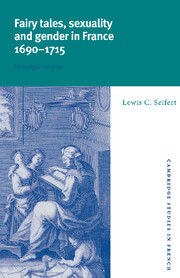Book contents
- Front Matter
- Contents
- Acknowledgments
- Note on translations and quotations
- Introduction
- Part I MARVELOUS STORYTELLING
- Chapter 1 Marvelous realities: toward an understanding of the merveilleux
- Chapter 2 Reading (and) the ironies of the marvelous
- Chapter 3 The marvelous in context: the place of the contes de fées in late seventeenth-century France
- Part II MARVELOUS DESIRES
- Afterword
- Notes
- Selected bibliography
- Index
- Cambridge Studies in French
Chapter 3 - The marvelous in context: the place of the contes de fées in late seventeenth-century France
Published online by Cambridge University Press: 22 September 2009
- Front Matter
- Contents
- Acknowledgments
- Note on translations and quotations
- Introduction
- Part I MARVELOUS STORYTELLING
- Chapter 1 Marvelous realities: toward an understanding of the merveilleux
- Chapter 2 Reading (and) the ironies of the marvelous
- Chapter 3 The marvelous in context: the place of the contes de fées in late seventeenth-century France
- Part II MARVELOUS DESIRES
- Afterword
- Notes
- Selected bibliography
- Index
- Cambridge Studies in French
Summary
Praising the restraint with which Perrault uses the marvelous, Mary-Elizabeth Storer asserts that in his tales “fairy magic (féerie) is made plausible, contemporary so to speak, and an atmosphere of reality is created by details to which a La Fontaine or a La Bruyère could not have given more attention” (La Mode, 103). Storer's statement relies on what continues to be a fundamental and largely unchallenged assumption in much criticism on the contes de fees: the marvelous is acceptable to the extent that it is used sparingly and plausibly. But in so far as fantasy literature, by its very definition, defies an empirical or realistic explanation of narrative action, observations such as Storer's are bewildering. Why should fairy tales be expected to minimize their use of the marvelous? Why should a fundamentally implausible narrative effect be judged in terms of plausibility? At least part of the answer can be found in critical stereotypes that take rationality to be the defining feature of French “classical” literature. In this perspective, the contes de fées are an aberration to be ignored, explained away, or at best subjected to this standard. To be sure, much recent work militates against a simplistic view of “reason” and even “classicism” as the hallmarks of seventeenth-century French literature. The fact remains, however, that the first vogue of fairy tales, because of its merveilleux, is strikingly original in the history of seventeenth-century French literary forms.
- Type
- Chapter
- Information
- Fairy Tales, Sexuality, and Gender in France, 1690–1715Nostalgic Utopias, pp. 59 - 98Publisher: Cambridge University PressPrint publication year: 1996
- 1
- Cited by

